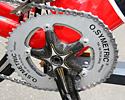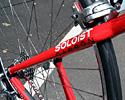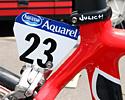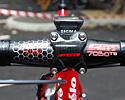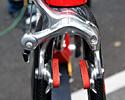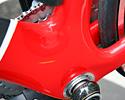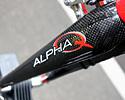
Recently on Cyclingnews.com |
Pro bike: July 8, 2005
Bobby Julich's CSC Cervélo Carbon Soloist
A secret no moreBy John Stevenson For the last couple of months CSC riders have been turning up at races aboard mysterious bikes bearing only the name of the team or its bike sponsor Cervelo. At the Tour de France, the identity of those bikes was finally revealed and as many Cyclingnews readers had correctly speculated, this is the carbon fiber version of Cervelo's versatile Soloist bike. The carbon Soloist is Cervelo's answer to the "which bike shall I ride" question that faces its sponsored riders (and those affluent enough to have more than one Cervelo in their quiver). The choice was previously between Cervelo's lightweight R2.5 and the aerodynamic Soloist, but Cervelo says the dilemma is solved: the Soloist Carbon is around the same weight as the R2.5 and more aerodynamic than the regular Soloist. According to Cervelo, the Carbon Soloist is the result of several years work, with a long period of initial behind-the-scenes development of aerodynamics, stress analysis and materials science. The first road-testable prototype was delivered to CSC during the Giro d'Italia in May and subsequent versions saw action at the Dauphiné-Libéré and the Tour of Switzerland. These were the almost anonymous mystery bikes that popped up under riders such as Franck Schleck and Christian Vandevelde. (Spotting a pic of Vandevelde on one of the protos, Cyclingnews reader Michael Sobray observed that it, "looks like a cross between a Soloist and a R2.5". Spot on!) The CSC team now has the Carbon Soloist at its disposal at the Tour, and Bobby Julich is among the riders using the new frame. Not surprisingly, the set-up of Julich's Carbon Soloist is very similar to the set-up of the aluminium Soloist Julich rode to victory at Paris-Nice. When you know things work, you don't mess with them too much, so Julich's Tour bike has the same 130mm FSA 115 stem and 42cm FSA RD200 handlebar as his Paris-Nice machine, and the same Selle Italia Max Flite seat. Also common to both bikes are the O.Symetric Harmonic elliptical chainrings on 172.5mm FSA cranks. Julich's well-used FSA's Superlight cranks were starting to look, well, used back in March - we're pleased to observe that the new bike has a shiny new set! As we mentioned back in March, the O.Symetric Harmonic design isn't a resurrection of Shimano's Biopace rings of the 1980s. An elliptical chainring changes the effective gear ratio as you pedal. Biopace reduced the gear ratio as crank passed through the horizontal; the O.Symetric Harmonic increases it. The idea is that the sector of the pedal stroke where the crank is horizontal or nearly so is where you can push hardest, so it makes sense to increase the gear at that point, then drop it to get your foot through top and bottom dead center quickly. This is an idea that's come and gone many times in the last 100 years or so, but it clearly seems to work for Bobby Julich. It causes teeth-grinding among the team's mechanics, though, because it's tricky to get the front derailleur to work properly when the chainring is in effect moving up and down under the derailleur. In fact, Shimano used to claim that one of the reasons it abandoned Biopace was that indexed shifting of the front derailleur on triple chainrings couldn't be made to work well with elliptical rings. As always, Julich uses Speedplay Zero pedals in CSC team issue red. One new piece of equipment for the CSC team this year is team-issue wheels, developed by wheel sponsor Zipp. Lightweight aluminium wheels for clincher tyres, the Zipp Team CSC wheels are the result of two years work between Zipp and Team CSC, and are claimed to weigh just 1500g per pair. The Zipp Team CSC wheels will be a welcome sight for fans of 'traditional' wheel building. The 95/220 hubs have conventional flanges that take regular, J-shaped spoke heads, and at the rim we find good old square spoke nipples. The rear wheel uses 32 DT Aerolite spokes and there are 28 up front. Zipp says the rims are made in Switzerland and given that the wheels use DT spokes, it's hard not to suspect that these are a custom version of DT's RR1.1 rims. CSC has the full range of Zipp wheels to go at, and Julich is often seen aboard the company's 404 carbon-rimmed wheels, which is why his bike is set up with carbon-ready brake pads in its Shimano Dura-Ace brakes. Photos
Images by Anthony Tan/Cyclingnews.com
Images by Earl Zimmermann
| |||||||


